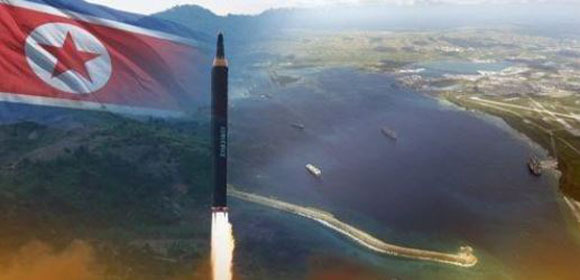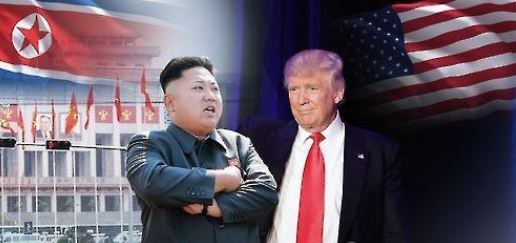N. Korea wants to show its ability to strike Guam: experts
By YonhapPublished : Aug. 29, 2017 - 15:09
North Korea's firing of a ballistic missile over Japan on Tuesday is apparently aimed at showing that it's not bluffing with its recent threat to strike waters near Guam, experts here said.
They believe the North's focus this time was likely testing the atmospheric re-entry technology of its mid-range ballistic missiles for possible combat use.
The North launched what appears to be an intermediate-range ballistic missile from Pyongyang early Tuesday morning. It flew more than 2,700 kilometers at a maximum altitude of around 550 km. It was the country's first-known ballistic missile launched from its capital.
Noteworthy is that the missile was fired on the standard trajectory of 30-45 degrees in contrast to the communist nation's practice of test-launching mid-range ballistic missiles at a lofted angle to avoid flying over Japan.
The North's launch of an IRBM-class missile at a normal angle is unprecedented.
It's a "big deal," David Wright, a co-director of the Union of Concerned Scientists, said.
They believe the North's focus this time was likely testing the atmospheric re-entry technology of its mid-range ballistic missiles for possible combat use.
The North launched what appears to be an intermediate-range ballistic missile from Pyongyang early Tuesday morning. It flew more than 2,700 kilometers at a maximum altitude of around 550 km. It was the country's first-known ballistic missile launched from its capital.
Noteworthy is that the missile was fired on the standard trajectory of 30-45 degrees in contrast to the communist nation's practice of test-launching mid-range ballistic missiles at a lofted angle to avoid flying over Japan.
The North's launch of an IRBM-class missile at a normal angle is unprecedented.
It's a "big deal," David Wright, a co-director of the Union of Concerned Scientists, said.

In May, in fact, the North fired an apparent IRBM at a lofted angle that traveled only about 780km at the apogee of some 2,100 km.
"North Korea has boasted its Guam strike capability with the flight trajectory of the ballistic missile like that in a real combat," said Chang Young-keun, a missile expert at Korea Aerospace University. "The launch this time should be regarded as a realistic threat, not a simple test."
Guam, approximately 3,000km southeast of North Korea, hosts key US naval and air force bases to be used for a bridgehead for dispatching US troops to Korea in the event of an emergency situation.
It is still unconfirmed, however, whether the secretive North has mastered the re-entry technology, according to the South's intelligence community.
The question is whether the warhead of the missile remained intact at the time of re-entry.
Other pundits agreed that Pyongyang's aim was to hone its skills to carry out threats of sending missiles toward Guam, braving Japan's fierce protest.
North Korean ballistic missiles had flown over Japan only twice, in 1998 and in 2009.
Earlier this month, the North threatened to fire four Hwasong-12 IRBMs toward Guam amid a trade of bellicose rhetoric with US President Donald Trump.

"I think that the North probably made a provocative act (that displayed its missile capability) as it can't fire missiles toward Guam, which means an attack on the US," said Koh Yu-hwan, a professor at Dongguk University in Seoul.
The move came amid a conciliatory gesture from US officials once emboldened by no news of the North's provocation until last weekend. They construed Pyongyang's "restraint" as heralding "positive" things.
Tensions between North Korea and the US appeared to be abating as North Korean leader Kim Jong-un held off on his Guam threat.
Observers had described the coming weeks or months as a "golden time" in efforts to bring Pyongyang to the negotiating table as the South Korea-US military exercise, code-named Ulchi Freedom Guardian, is scheduled to end this week. There will be no regular joint military training of the allies until spring next year.
Tensions, however, spiked again over the weekend.
On Saturday, the repressive regime fired three short-range ballistic missiles into the East Sea, resuming its provocation after a one-month lull. Despite the test, US Secretary of State Rex Tillerson said he is willing to have talks with the North.
South Korea's presidential office also said that North Korea's "low-intensity" provocation may indicate its intent not to aggravate the situation, voicing hope for future dialogue with Pyongyang.
Analysts said that Pyongyang seems to be defiant toward Washington's talk of dialogue, which it regards as lacking sincerity without concrete actions.
The United Nations Security Council recently slapped fresh sanctions on Pyongyang over the North's two intercontinental ballistic missile tests in July.
The US has also imposed new sanctions on 10 entities and six individuals, including those based in China and Russia, for their alleged links to North Korea's nuclear and missile program.
Last week, China announced measures to ban North Korea from doing new business in China in line with the UN sanctions.
The UN panel convened another emergency session on North Korea shortly after its latest provocation. Many expect it to adopt a statement denouncing the North's move rather than pushing for another sanctions resolution.
President Moon Jae-in also called for a stern response, ordering the military to display its "overwhelming" capability against North Korea's provocation.
Over the phone, Trump and Japanese Prime Minister Shinzo Abe agreed that now is not the right time for dialogue with Pyongyang, calling for increased pressure, according to Japan's Kyodo News.
"There are no signs of meaningful dialogue between the US and the North although Tillerson is talking about dialogue," said Kim Dong-yub, a professor at the Institute for Far Eastern Studies at Kyungnam University. "Against this backdrop, the North appears to be trying to show that its missile strike threat is not empty talk."
North Korea earlier said that it will never put its nuclear and missile programs on the negotiation table.
"Kim Jong-un has a goal to complete the development of its nuclear and missile program," Koh pointed out. "There seems to be no change in its stance that it will come to dialogue after securing a strategic status favorable to it." (Yonhap)



![[AtoZ into Korean mind] Humor in Korea: Navigating the line between what's funny and not](http://res.heraldm.com/phpwas/restmb_idxmake.php?idx=644&simg=/content/image/2024/04/22/20240422050642_0.jpg&u=)
![[Exclusive] Korean military set to ban iPhones over 'security' concerns](http://res.heraldm.com/phpwas/restmb_idxmake.php?idx=644&simg=/content/image/2024/04/23/20240423050599_0.jpg&u=20240423183955)



![[Graphic News] 77% of young Koreans still financially dependent](http://res.heraldm.com/phpwas/restmb_idxmake.php?idx=644&simg=/content/image/2024/04/22/20240422050762_0.gif&u=)
![[Herald Interview] Why Toss invited hackers to penetrate its system](http://res.heraldm.com/phpwas/restmb_idxmake.php?idx=644&simg=/content/image/2024/04/22/20240422050569_0.jpg&u=20240422150649)






![[Exclusive] Korean military to ban iPhones over security issues](http://res.heraldm.com/phpwas/restmb_idxmake.php?idx=652&simg=/content/image/2024/04/23/20240423050599_0.jpg&u=20240423183955)



![[Today’s K-pop] Ateez confirms US tour details](http://res.heraldm.com/phpwas/restmb_idxmake.php?idx=642&simg=/content/image/2024/04/23/20240423050700_0.jpg&u=)